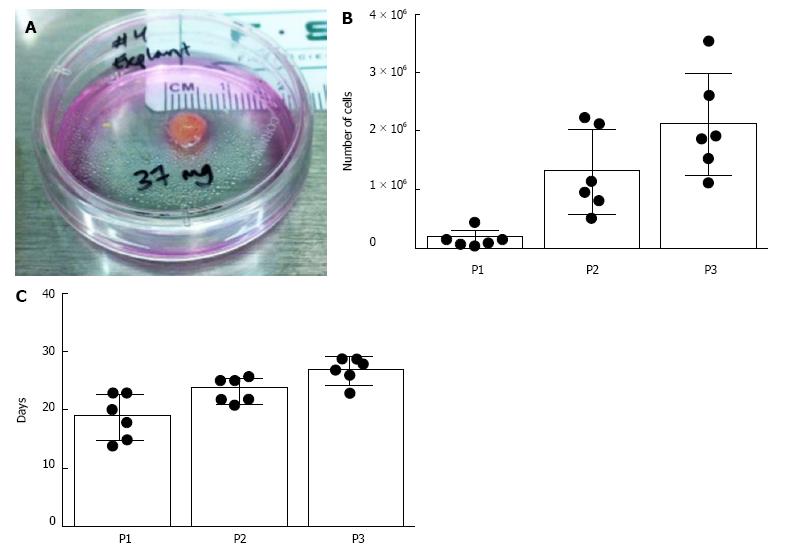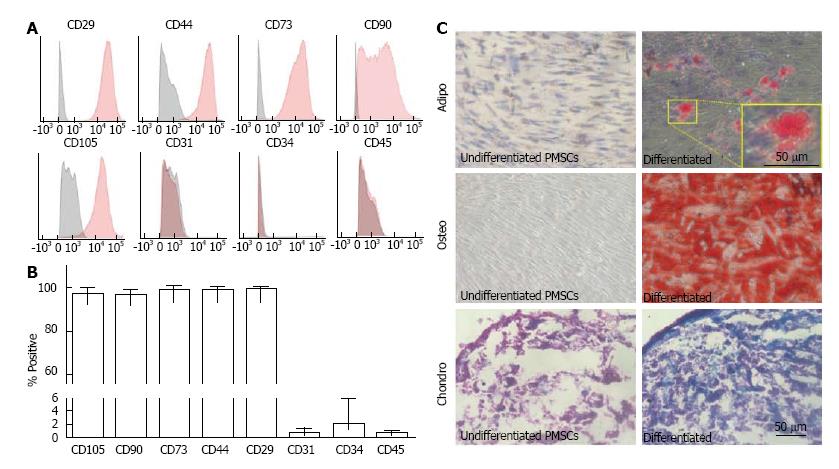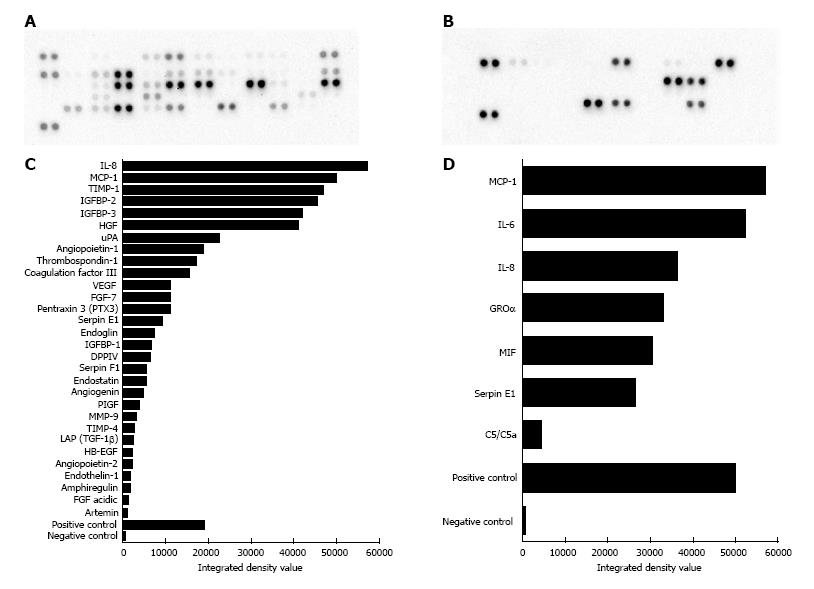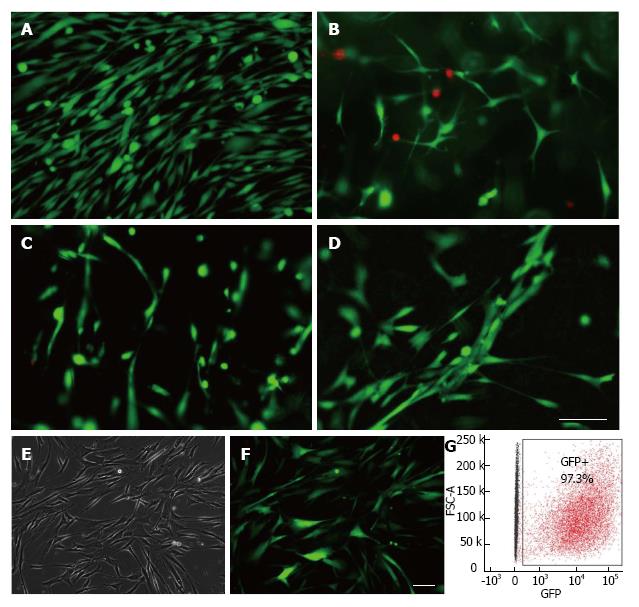Copyright
©The Author(s) 2015.
World J Stem Cells. Jan 26, 2015; 7(1): 195-207
Published online Jan 26, 2015. doi: 10.4252/wjsc.v7.i1.195
Published online Jan 26, 2015. doi: 10.4252/wjsc.v7.i1.195
Figure 1 Early passage growth of placenta-derived mesenchymal stromal cells from chorionic villus sampling-size tissues.
Placenta-derived mesenchymal stromal cells (PMSCs) were isolated and expanded from chorionic villus sampling (CVS)-size tissue samples (n = 6). A: Photograph of a representative CVS-size mass of human early gestation chorionic villus tissue. The average tissue mass used in this experiment was 35.9 mg; B: Cell expansion data from the first three passages show that an average of 2.09 × 106 cells were obtained by the third passage; C: Average days in vitro until passages 1, 2, and 3 were 18.83, 23.5, and 27 d, respectively.
Figure 2 Placenta-derived mesenchymal stromal cells express typical mesenchymal stromal cells surface markers and are multipotent.
A, B: Placenta-derived mesenchymal stromal cells (PMSCs) were found to be mostly positive for well-established MSC markers CD29, CD44, CD73, CD90, and CD105, and mostly negative for hematopoietic and endothelial cell markers CD31, CD34, and CD45 (n = 6); C: Cells were multipotent and were capable of differentiating into adipocytes, osteocytes and chondrocytes in vitro. Images in the left column show negative control samples (normal media only) while those on the right display cultures grown in induction media. Yellow boxes provide a magnified view of the selected area. Scale bar = 50 μm.
Figure 3 Immunofluorescence staining of placenta-derived mesenchymal stromal cells reveals stem cell phenotype.
Placenta-derived mesenchymal stromal cells (PMSCs) were probed using immunofluorescence and found to express intracellular structural proteins Nestin, NFM, and S100β that are often associated with neural-lineage phenotypes. Additionally, PMSCs were positive for developmental transcription factors Sox10 and Sox17. Scale bar = 100 μm. NFM: Neurofilament medium.
Figure 4 Robust paracrine secretion by placenta-derived mesenchymal stromal cells.
A, C: Results from the human angiogenesis array kit detected 30 secreted factors with integrated density values above 103. A: Original membrane image from the Angiogenesis array, and C: corresponding graph showing measured integrated density values of detected spots. Functions of proteins identified here include modulation of angiogenesis, chemotaxis, stimulation of cell proliferation, blood vessel maturation, blood coagulation, and extracellular matrix remodeling. B, D: Results from the panel A array kit detected 7 secreted factors with integrated density values above 103. B: Original membrane image from the Panel A array; D: Corresponding graph showing measured integrated density values of detected spots. Many of these proteins have distinct functions related to the cell chemotaxis and immune response. TGF: Transforming growth factor; IL:Interleukin; VEGF: Vascular endothelial growth factor; GROα: Growth regulated oncogene alpha; MCP-1: Monocyte chemotactic protein 1; uPA: Urokinase-type plasminogen activator.
Figure 5 Placenta-derived mesenchymal stromal cells are compatible with biological and synthetic delivery vehicle matrices.
A-D: Cell viability was assessed using Molecular Probes Live/Dead fluorescent assay kit for PMSCs cultured in various delivery vehicles. Results show that PMSCs were viable when culture in A: two-dimensional culture (control); B: 2 mg/mL collagen hydrogel; C: 5 mg/mL fibrin glue, D: an aligned PLLA/PLGA nanofiber scaffold. E-G: PMSCs can be efficiently transduced with Luciferase-GFP-containing lentiviral vector; E: phase contrast; F: green fluorescence images from the same field of view of transduced PMSCs; G: Flow cytometry analysis of transduced PMSCs indicate that they were transduced with an efficiency of 97.3%. Scale bars = 100 μm. PMSCs: Placenta-derived mesenchymal stromal cell.
- Citation: Lankford L, Selby T, Becker J, Ryzhuk V, Long C, Farmer D, Wang A. Early gestation chorionic villi-derived stromal cells for fetal tissue engineering. World J Stem Cells 2015; 7(1): 195-207
- URL: https://www.wjgnet.com/1948-0210/full/v7/i1/195.htm
- DOI: https://dx.doi.org/10.4252/wjsc.v7.i1.195













